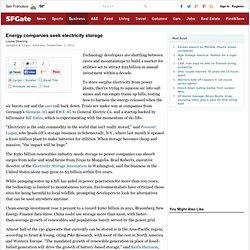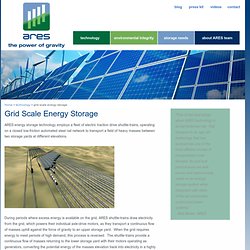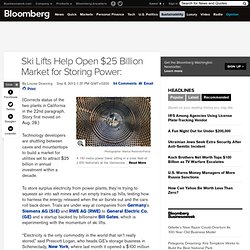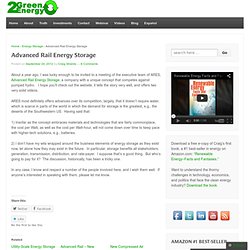

Train-Based Energy Storage: Making Renewable Energy Reliable With Gravity. First Posted: Apr 03, 2013 05:39 PM EDT TagsRenewable energy, solar power, Wind Power The sun rises over a windmill farm near Palm Springs, California.

Credit:Reuters Gravity storage has been on the minds of green energy enthusiasts for years, as the dominant method so far of helping renewable energy become reliable energy. Jim Kelly, CEO of Advanced Rail Energy Services in California, is looking forward to testing out a means of storing electricity that is efficient, innovative and unexpected –– by moving trains. An engineer with Southern California Edison for 38 years, Kelly and his team at ARES want to store the excess energy created by photovoltaic solar panels and wind turbines, and use it to move trains, weighed down with cars filled with gravel, up an incline, where they would wait and hold onto the energy used to get them there.
Like Us on Facebook Kelly’s train project has its challenges as well, requiring eight miles of track to store 500 megawatts of electricity. View topic - Advanced Rail Energy Storage (ARES) - grid storage system. Energy companies seek electricity storage. Technology developers are shuttling between caves and mountaintops to build a market for utilities set to attract $25 billion in annual investment within a decade.

To store surplus electricity from power plants, they're trying to squeeze air into salt mines and run empty trains up hills, testing how to harness the energy released when the air bursts out and the cars roll back down. Trials are under way at companies from Germany's Siemens AG and RWE AG to General Electric Co. and a startup backed by billionaire Bill Gates, which is experimenting with the momentum of ski lifts. "Electricity is the only commodity in the world that isn't really stored," said Prescott Logan, who heads GE's storage business in Schenectady, N.Y., where last month it opened a $100 million plant to make batteries for utilities.
When storage becomes cheap and massive, "the impact will be huge. " Electricity and Power Storage - Ares North America. Energy Storage - Grid Scale Energy Storage - Ares North America. ARES energy storage technology employs a fleet of electric traction drive shuttle-trains, operating on a closed low-friction automated steel rail network to transport a field of heavy masses between two storage yards at different elevations.

During periods where excess energy is available on the grid, ARES shuttle-trains draw electricity from the grid, which powers their individual axle-drive motors, as they transport a continuous flow of masses uphill against the force of gravity to an upper storage yard. When the grid requires energy to meet periods of high demand, this process is reversed.
The shuttle-trains provide a continuous flow of masses returning to the lower storage yard with their motors operating as generators, converting the potential energy of the masses elevation back into electricity in a highly efficient process. ARES rail based energy storage systems are covered by one or more of the following US patents: 8593012, 8674541 with foreign patents pending and issued. ARES-Technology. ARES_PressKit.pdf. Ski Lifts Help Open $25 Billion Market for Storing Power: (Corrects status of the two plants in California in the 22nd paragraph.

Story first moved on Aug. 28.) Technology developers are shuttling between caves and mountaintops to build a market for utilities set to attract $25 billion in annual investment within a decade. To store surplus electricity from power plants, they’re trying to squeeze air into salt mines and run empty trains up hills, testing how to harness the energy released when the air bursts out and the cars roll back down. Trials are under way at companies from Germany’s Siemens AG (SIE) and RWE AG (RWE) to General Electric Co. (GE) and a startup backed by billionaire Bill Gates, which is experimenting with the momentum of ski lifts. “Electricity is the only commodity in the world that isn’t really stored,” said Prescott Logan, who heads GE’s storage business in Schenectady, New York, where last month it opened a $100 million plant to make batteries for utilities. Water Uphill $25 Billion Estimate Compressed Air California Project.
Renewable Energy Business and Investing. About a year ago, I was lucky enough to be invited to a meeting of the executive team of ARES, Advanced Rail Energy Storage, a company with a unique concept that competes against pumped hydro.

I hope you’ll check out the website; it tells the story very well, and offers two very solid videos. ARES most definitely offers advances over its competition, largely, that it doesn’t require water, which is scarce in parts of the world in which the demand for storage is the greatest, e.g., the deserts of the Southwestern US. Having said that: 1) Insofar as the concept embraces materials and technologies that are fairly commonplace, the cost per Watt, as well as the cost per Watt-hour, will not come down over time to keep pace with higher-tech solutions, e.g., batteries. 2) I don’t have my wits wrapped around the business elements of energy storage as they exist now, let alone how they may exist in the future.
Like this: Like Loading...